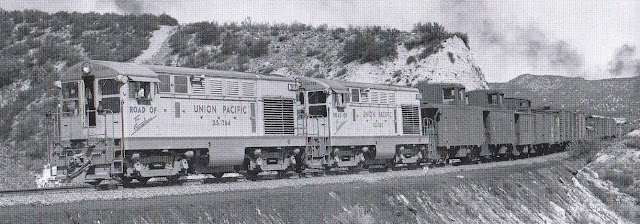This time we'll cover the UP's Fairbanks-Morse H20-44 diesel helpers in Victorville, and then we'll look at my progress in finishing the cork roadbed around the mainlines of the staging deck.
In August of 1947 the UP brought in five new FM H20-44 diesels, #1360-1364, to start replacing their steam loco helpers on Cajon Pass. In Nov-Dec. of 1947 they brought in six more, #1365-1370, to complete the replacement of their steam helpers (until the return of UP steam in 1950-51, that is).
Here's a great photo of #1360 waiting near the water tanks in Victorville in Nov. 1947 to help the next westbound freight, thanks to Jack Whitmeyer:
Here's a beautiful shot of #1360 helping the eastbound Los Angeles Limited around Sullivan's Curve in June of 1950, thanks again to Jack Whitmeyer:
Here's a UP company photo of #1363 about to help a freight:
Back in Victorville, here's a Stan Kistler photo of new #1361 in Sep. of 1947:
Here we see #1360 and an FA unit pushing a freight up Cajon Pass, as shot by Chard Walker:
Here's a Donald Duke shot of #1364 and #1361 pushing another freight up Cajon Pass in the summer of 1948:
Here we see #1360 and a partner returning light to San Bernardino (along with some Santa Fe FT helpers) while an eastbound Santa Fe steam loco works upgrade out of town, thanks to Chard Walker:
Besides serving as helpers, the H20-44s also pulled the UP's Leon Turn local freight to the cement plants at Victorville and Oro Grande. Here is #1365 with its caboose at Summit in Jan. 1949, heading to Victorville to pick up some loads, as shot by Chard Walker:
But these units were not great as helpers, so in mid-1950 the UP replaced them all by bringing back some steam locos again. So the lifetime of these units on Cajon Pass ran from mid-1947 to mid-1950.
As for HO models, I only know of the old Alco Models brass model, as seen here after being painted:
I have two of these that have been painted, and recently I found a third one.
Now let's look at my layout progress. I worked an hour or two each day, gluing down cork roadbed along the double-track mainlines all the way around the edges of the lower deck, until the loop was complete.
Here's the new roadbed as it curves through Sections 4 and 5, along with some tools of the trade:
Moving along, here's the next roadbed, running through Sections 5 and 6:
And the final leg of the course, running through Sections 6, 6A, and back to Section 2 in the distance:
A couple of sheets of Midwest cork are laid beside the mainlines, to give some idea of where they will support all the turnouts into the A Yard in this area.
The next steps were to complete the cork wedges at the turnouts in Section 2, and then to lay out and mark the future turnout locations in Sections 6 and 6A:
In the lower right are two of the twelve Midwest cork squares (12x12") that I bought to supplement the four large sheets (all 5 mm thick).
But all the rest of my larger cork sheets came from a carpet store and are 6 mm thick, so I began planning where the 5-mm cork should end (after supporting the turnouts) and the 6-mm cork should begin (where there are no more turnouts, just storage tracks). The transition will be sanded down.
Here's a drawing I made to mark the turnout locations and the boundaries of the 5-mm cork sections:
As you can see, they are basically triangle-shaped areas around the turnouts.
I began work on making these by cutting out the triangular cork area that supports three turnouts into the A Yard at the top of this drawing. I also laid cork roadbed around the curve of track A1 between that area and the next cork area to the right of there in the drawing.
Here is what this first sheet cork area looks like so far, but the triangular sheet with three turnouts has not been glued down yet, and the two sheets of carpet cork to the right have not been glued down either:
So, my next steps are to continue cutting and fitting all the cork sheets for the main yards, and then to paint all the cork in two shades of gray, with lighter gray on the mainlines, as I did in the staging room over a year ago.















No comments:
Post a Comment